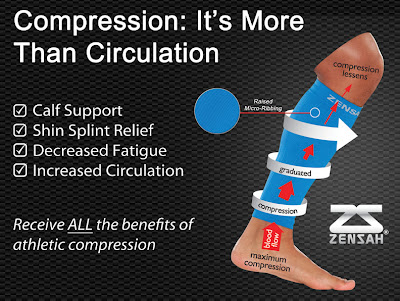*DISCLAIMER: I am not a medical professional, however I have been consistently running distance for 17 of my 30 years. Over these years I have suffered many types of injuries such as patella tendonitis, iliotibial band syndrome, shin splints, achilles tendonitis, plantar fasciitis, and turf toe to name a few. It is my hope that some of my experience with these issues will help you as well. As always, please see a medical professional for any injury you may be experiencing.
One of the first, and maybe the most prominent issues that a runner or walker may have may involve the knee. There are a myriad of knee pain that can occur, but iliotibial band syndrome (also referred to simply as IT band syndrome) and patella tendinitis are probably two of the most common. IT band syndrome can be described as a pain on the outside of the knee or hip. Generally rest, stretching it out, or using products such as a foam roller or a small knee strap designed to go over the knee can help relieve this pain. Patella tendinitis is a general knee pain, usually in the front of the knee, and a full knee brace with some compression or simply a strap under the knee could temporarily help alleviate some of the pain. As with most repetitive injuries, rest, good shoes, and a softer surface to run on can help with knee injuries. Patella tendonitis and IT band syndrome are just two different types of injuries that can affect the knees and upper legs of runners or walkers.
Moving below the knee, shin splints and achilles tendonitis are two issues that seem to be three of the most common. Achilles tendonitis is a term that is used quite often, but the term is a bit misleading. By my reading, 'tendinitis' is a term that actually means inflammation, however in most cases, inflammation in the tendon is rarely the cause of the pain. 'Tendinosis' or 'tendinopathy' are actually more correct terms to refer to tiny micro tears in the achilles that much more commonly cause the pain, and there is a brace for this issue that is similar to the knee strap but made for the lower leg. As for shin splints, lower leg compression, proper shoes, and a softer running surface could help out. As with most lower leg issues, proper stretching, especially with the assistance of items such as the ProStretch tend to help. Lower leg injuries are another common set of issues that runners and walkers are faced with.
Finally, it is important to remember that when it comes to activities such as running or walking, everything starts with the feet, and when your feet hurt, you hurt. First and foremost, proper shoes for any activity are key. Past that, some people may still be affected by injuries such as plantar fasciitis, Morton's neuroma, or bunions. Forefoot issues such as Morton's neuroma and bunions can generally be helped out with a shoe that is wide enough in the toe box, but in addition to that, metatarsal pads might help to take some pressure off of the affected area. Arch pain, heel pain, and general pain in the bottom of the foot can be described as plantar fasciitis, and as WebMD points out, it can be caused by many, many different things. What generally seems to work for most people is stretching, some extra support from an orthotic, and in more extreme cases, sleeping in with the foot in a flexed position with the help of something like a Strassburg Sock. Foot pain for runners and walkers is never fun, but there are many ways to deal with it and hopefully continue to pursue your goals.
It goes without saying, but running and walking injuries are never fun. With some patience and determination, however, you can make it past them continue along your path to physical fitness. As always, any products in this blog can be found at Run Fit Sports, and some video on this topic can be found here. If you are interested in any of this, please come see us or check us out online!
Happy Running!

No comments:
Post a Comment